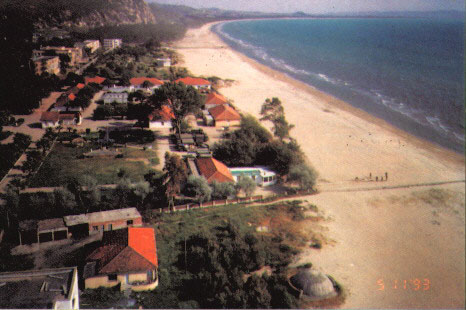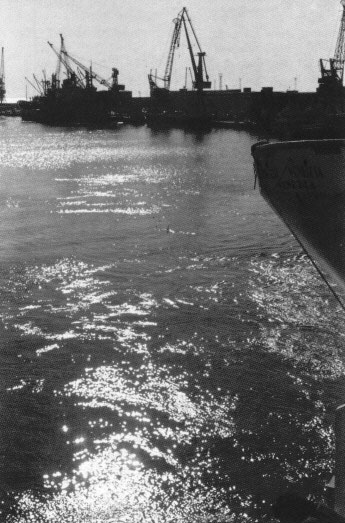Albania
> Durres

The beach of Durr's |
One of Albania's oldest cities, the country's
main sea port, the second largest industrial center
after Tirana. Durr's (pronounced: Dooh-ras) lies
on a small peninsula on the coast of the Adriatic
sea. Its population is around 85,000 (the second
largest city in Albania).
Durr's was established in the year 627 B.C. by
Korintha and Korkyra colonists, on the area of
an ancient settlement of the Illyrian tribe Taulant.
It went under the names Epidamn, Dyrrah, and Dyrrachium,
from which its present name has derived. Having
a large Illyrian population and trading with other
places, the city prospered. Ever since the 5th
century B.C., Durr's produced metals, ceramics,
fabric and leather, and had shipyards for making
ships. Durr's was a city-state with slaves and
a slave-owning class. Old coins found in the area
of Durr's are proof of its economical development
of this period, it was the city that put the Illyrian
Drachma into circulation. The arts and architecture
prospered, the Bukuroshja e Durr'sit (The
Beautiful Girl of Durr's) mosaic is one of the
most popular historical figures found here. In
the year 229 B.C., Durr's fell under Rome, but
it retained a semi-autonomy. It was turned into
a Roman colony during the rule of Augustus, around
the year 20 B.C. The Illyrian population gained
political power and rose high in administrative
positions, as is shown by many Illyrian names
found on inscriptions. Durr's developed during
the period between the 1st to the 3rd centuries
A.D., it became a major trading center and the
main port on the eastern coast of the Adriatic.
Craftsmanship developed, roads, libraries, aqueducts
and odeons were built, as was the Amphitheater
of Durr's. At the end of the 3rd century, Durr's
became the center of the province of New Epirus.
At the 4th century A.D., in spite of the crisis
in the Roman Empire, Durr's still remained a developed
trading center. And during the 5th and 6th centuries,
Durr's was an important city of the western part
of the Byzantine Empire, despite the attacks of
the Ostrogoths and other barbarians. Under the
rule of Anastas, who was born in Durr's, many
new buildings rose, such as the hippodrome, two
surrounding city walls, and the Basilica of Arapajt.
It was also an episcopal center. During the 10th
and 11th centuries suffered several attacks (it
was attacked by the Bulgarians from 989-1005;
by the Normans, 1082-1083, and it was set ablaze
by them in 1185; by Venice in 1205, which formed
the Duke of Durr's; by Carl of the Anzuins in
1272, which established the Kingdom of Arb'ria
and Durr's as its capital; and by the Serbs in
the beginning of the 14th century.) In the 14th
century, Durr's was Albania's largest city, with
around 25,000 inhabitants. In 1368, it was taken
by Karl Topia, and it became the center of the
Principality of Arb'ria. In 1392, the Ottoman
Turks reached the city, which was left under the
control of Venice by Gjergj Topia, and remained
in their control until 1508. Skenderbeg and his
troops surrounded the city in 1447. The city was
devastated after it was taken by the Ottomans,
most of the population fled, turning Durr's into
a village. It redeveloped in the 17th century,
once again became a trading center and port of
middle Albania. Durr's was severely damaged by
earthquakes, in 1372, 1905, and 1926.

|
During
and after the 1870s, the city grew slowly, and branches
of foreign shipping companies were opened here.
The citizens of Durr's participated in the Albanian
national liberation movement, during the years 1878-1881,
and 1910-1912. On November 21st, 1912, Ismajl Qemali
came to Durr's and on November 26th, 1912, the Albanian
flag of independence was risen at Durr's, but the
city was captured by the Serbs three days later.
The Serbs remained until May, 1913. On March 7th,
1913, Durr's became the capital of Albania. After
the fall of Wilhelm Wied, the Austrian prince appointed
King of Albania by the European powers, Durr's was
the scene of many uprisings. In 1916 it was captured
by the forces of Austria-Hungary, and in 1918 by
Italian forces. During the past nine centuries,
Durr's has changed hands from one ruler to another
33 times. After World War I, in December, 1918,
a national congress was held in Durr's, a temporary
administration of Durr's was appointed, which fell
in January, 1920, after the Congress of Lushnje.
The citizens of Durr's participated in the War of
Vlora, and in the democratic movements of the years
1921-1924. During the rule of Zog, Italian capital
went through Durr's, and many factories were built,
such as those for producing flour, cigarettes, and
pasta. After the damages of the earthquake of December
of 1926, wider roads were built, and the city gained
an appearance, especially near the port, similar
to that of its present appearance. During the 1930s,
Durr's marked a slow development, from 4700 inhabitants
it had in 1923, grew to 10,500 in 1938.
During 1939, Durr's was the center of resistance
to the Italian Fascist forces, which had occupied
the country. Many demonstrations and strikes were
held in the city, and in 1942 the National Liberation
Council was formed here. In August, 1943, the
city was taken by the Germans, which blew up the
port in 1944.
After World War II, Durr's was transformed into
an industrial city, and an important cultural
and educational center. The main fields of production
in today's Durr's are the industries of mechanics,
chemicals, electronics, furniture, plastic, rubber,
and food. Durr's produces wine, cigarettes, fish,
high tonnage ships, train cars, electric motors,
radio and television sets, plastic and rubber
articles, etc.
Durr's was the scene of many demonstrations during
the democratic movement of 1990-1991.
Aside from the main library, The Cultural Center
with the "Aleksander Moisiu" theater, Durr's has
the Estrada Theater, the Puppet Theater, the Philharmonic
orchestra, the artistic Ensemble "Durr'si," and
many other artistic groups. The museums that have
been built are the Archeological Museum, Museum
of History, and the house of Aleksander
Moisiu's family has been turned into a museum.
Durr's has many scientific associations and the
branch of the Artists and Writers Association
is active here.
The city has expanded on the north and the east,
whilst many new public and residential buildings
have been built, monuments of the ancient city
have been preserved. The main industrial zone
is at the entrance of the city from the east,
at the Shkozeti quarters. Durr's has many parks
and flower gardens, and the outdoor theater has
been built on the hills of the city. The main
recreational areas of Durr's are the Beach of
Durr's and the Beach of Currilave, where citizens
and tourists enjoy the sandy beaches and the clear
seawater of the Adriatic.
|